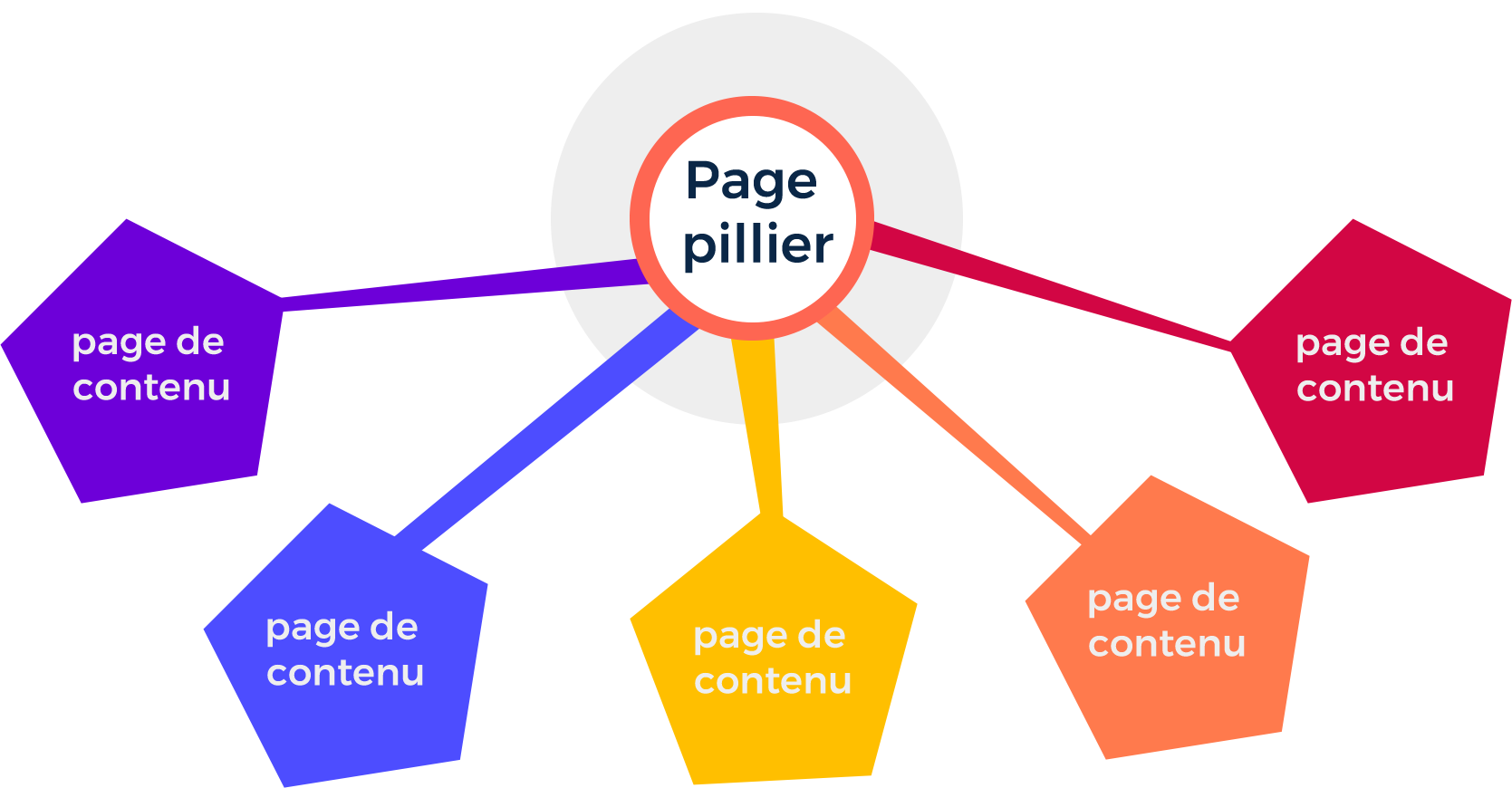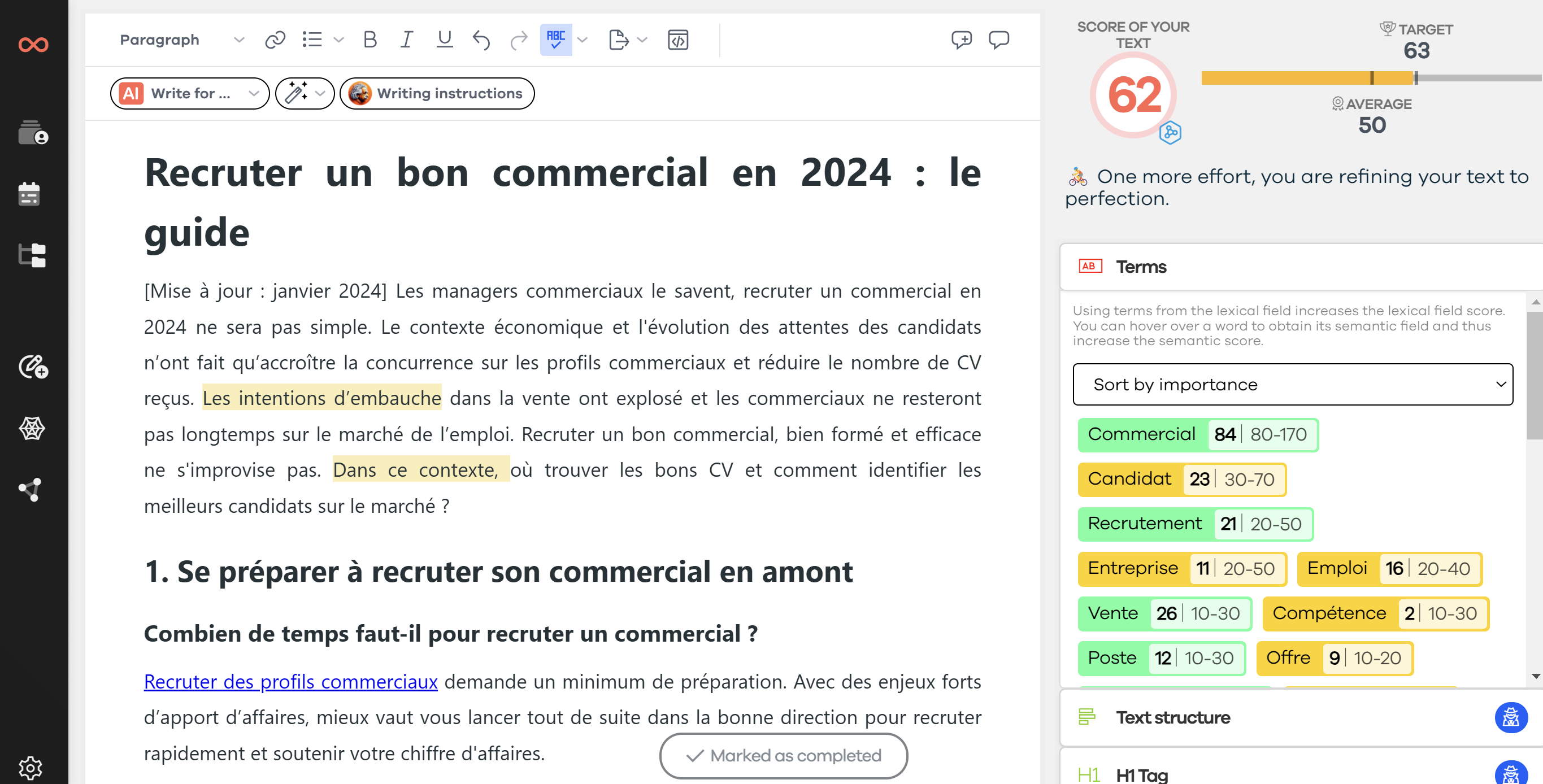Do you want to be visible on the Internet and increase your organic traffic? To do so, you need to know how to implement an effective SEO strategy. First, I will explain exactly what it is. Then, I will give you all the necessary steps to develop your natural referencing strategy and make it sustainable. Be aware that by reading this article, you will have a considerable advantage over your competition. Indeed, it is the fourth pillar of referencing that is too often neglected. After reading, you will know why and how to optimize your website in a thoughtful and efficient way.
💡 Definition of an SEO strategy

Before being able to establish a natural referencing strategy, you must answer an essential question: what is an SEO strategy?
It is a detailed plan aimed at improving the organic positioning of a website on search engines to obtain more natural traffic. In other words, an SEO strategy aims to provide a perfect match to the expectations of indexing robots and the query intentions of Internet users.
To achieve this, you must ensure that you meet the requirements of the three fundamental pillars of organic referencing: technique, content, and notoriety. Therefore, we can consider that the SEO strategy is the fourth pillar allowing directing all the actions to be carried out.
By defining your objectives and actions precisely and coherently, you will then be able to:
- estimate your necessary ranking in the SERP according to the chosen keywords;
- establish priorities;
- monitor your progress.
To achieve this, here are the key steps that will be detailed in the rest of this article:
🕵️♂️ Identify your SEO competition
🎯 Set your SEO goals
🔎 Analyze your website
⚙ Adjust the SEO technique
✒ Develop your content strategy
🔗 Implement a link building strategy
📈 Monitor the effectiveness of your SEO strategy
♾ Make the necessary updates
🕵️♂️ Identify your SEO competition

You cannot rush headlong and create an SEO strategy without knowing your competition. Indeed, the display of search engine results pages varies considerably depending on the theme of your business. There is no universal way to proceed. Thus, you must adapt your actions and ambitions according to the competitive reality of the SERP.
To determine your SEO competition accurately, here are the 6 steps I recommend you follow:
- find your competitors;
- study your rivals' keywords;
- dissect your competitors' websites;
- analyze the notoriety of your SEO competition;
- discover your opponents' activity on social networks;
- observe the evolution of your competitors.
For more details on this subject, I invite you to read this blog post: "How to conduct a competitive analysis in SEO?"
🎯 Set your SEO goals

Now that you know your competition and have accurately defined your target audience, you can set your goals. As a reminder, the purpose of your SEO strategy is to satisfy Google's algorithm requirements while accurately responding to users' query intentions. This preliminary work is therefore essential to define your goals realistically.
The SMART method
It is essential to establish your objectives before implementing any action. Indeed, without a specific goal, you will not be able to concretely measure the return on investment of your natural referencing. To determine your SEO objectives, I recommend using the SMART method:
- Specific: the objective must be simple and understandable so that the action taken corresponds exactly to expectations.
- Measurable: set up KPIs (detailed below) to quantify the objective to be achieved.
- Achievable: for the objective to be accepted, it must be ambitious while remaining reasonable.
- Realistic: based on the competitive analysis, you will know how to define the SEO potential of your theme.
- Temporal: set a deadline to achieve your goal (depending on the measures taken, allow at least six months to improve your natural referencing).
KPIs
From the English "Key Indicator Performance," these are the key performance indicators that you associate with your previously defined objectives. Here is a non-exhaustive list of the different SEO factors that you can analyze to measure your progress:
- First-page ranking: these are the keywords that actually bring you organic traffic. Your goal is to surpass all your competitors to reach the top three.
- Second-page ranking: these are the keywords on which you need to continue working to be truly visible on the Web.
- Click-through rate: if the CTR (Click Through Rate) is low while you are well positioned, you can focus your SEO strategy on optimizing metadata.
- Organic sessions: find out exactly how much traffic you get from natural referencing.
- Number of pages per session: better understand your visitors' behavior and adapt your internal linking and CTAs (Call to Action).
- Conversion rate: a real indicator of your SEO campaign's ROI, this indicator allows you to determine the most effective landing pages.
- Referring domains: monitor the evolution of external links leading to your website.
🔎 Analyze your website

As you know the quality of your competitors' websites and are aware of good SEO practices, you will be able to analyze the technique of your own site. Your goal will be to ensure that you meet Google's algorithm expectations and match (or even surpass!) the functionality of competing sites. You will then know which factors to prioritize for a successful SEO strategy.
SEO audit
This work must, of course, be carried out by a natural referencing specialist. Indeed, for an in-depth analysis, online tools are not sufficient. Perfect knowledge of SEO and unique skills in the referencing profession are required.
With this detailed document, you will know all the elements to optimize to have a website adapted to search engine referencing criteria. You can then define with precision the priority elements to work on to improve your ranking on Google.
Points not to be neglected in SEO
In my article dedicated to 130 essential points of an SEO audit, I detail each element allowing a complete analysis of your website. However, here are the main lines:
- SEO technique;
- site architecture;
- Google audit;
- keyword examination;
- "on-page" analysis (loading speed, HTML, etc.);
- "off-page" audit (link building and backlinks);
- UX control;
- adaptation to mobile versions.
⚙ Adjust the technical SEO strategy

With the detailed analysis obtained through the audit, you can then get to the heart of the matter and take concrete action to implement your SEO strategy. Your base must be solid, which is why I recommend that you first focus on the technical part of your website.
During this phase, you must focus on search engine recommendations and user experience. Below are the essential elements to achieve this.
Technical factors of natural referencing
This represents only a part of the technical SEO factors, but they are certainly the priority elements for carrying out your referencing strategy. Remember the 80/20 rule: 20% of your actions generate 80% of your results. So don't spread yourself too thin and adapt your optimization work accordingly.
- HTTPS: a secure site is an indicator of trust for both the user and Google.
- HTML: HTML markup allows you to structure your texts to improve search engine understanding.
- 404 errors: redirecting missing pages improves the crawl of indexing robots.
- Sitemap: this file is a good way to speed up the complete navigation of your site by search engines.
- Robots.txt: you can direct Google's robots to highlight important pages and avoid indexing unnecessary pages.
User experience
UX is now at the heart of search engine concerns and algorithms are therefore updated to improve this point. This is excellent news for your SEO strategy, as you can focus mainly on the human aspect, rather than on indexing robots.
- Facilitate the reading of your web pages: a breadcrumb trail, a table of contents, a pleasant layout, and a coherent structure are all elements that favor the comfort of your reader.
- Improve loading speed: according to studies on the relationship between loading speed and user experience, a site that takes more than three seconds to load loses more than 50% of its traffic.
- Adapt your site to mobile versions: more than 50% of Internet users are now mobile users. It is therefore necessary to offer them an optimal experience on mobiles and tablets.
- Reduce popups and advertising: the untimely appearance of email capture windows or advertising tends to scare away your reader. Although they remain essential, you must set them up sparingly.
Once these essential technical elements are in place, you can then gradually focus on the more than 200 SEO factors taken into account by search engine algorithms.
✒ Develop your content strategy

Content is king! Of course... but that doesn't mean that you just have to work on it to succeed in your SEO strategy. It rather means that if you don't have content to offer, indexing robots won't know the theme of your site, and the user won't find an answer to what they are looking for. It is therefore essential not to neglect the other aspects of SEO.
As your simple intuition cannot be sufficient to develop a comprehensive keyword strategy, I invite you to discover our complete content creation assistance tool.
Keyword research
At the beginning of the development of your natural referencing strategy, you studied your competition in Google's SERP. You were thus able to determine the list of keywords that bring the most traffic and have the best potential for your visibility.
However, you also want to adapt this list to your brand and your clientele. Always keep in mind that the purpose of your content strategy (also called editorial strategy) is to respond relevantly to the search intentions of Internet users and generate as much qualified traffic as possible. To do this, here are other types of key queries that you can add to your table:
- Local searches: local referencing is an excellent way to reach your potential reader in a given region. Often less competitive than a national query, it is an excellent starting point for implementing your SEO strategy.
- National queries: often more general and more competitive, national searches allow you to reach a larger audience. Pay particular attention to the content of these pages.
- International traffic: if you are targeting international business, you will have even more competition. Landing pages will therefore need to be perfectly optimized to outperform your rivals on Google.
- Long tail: although they generate less traffic, long tails allow you to reach an extremely qualified readership. Your conversion rate is therefore likely to be higher on this type of keyword.
- Frequent questions: Google helps you to know the most frequently asked questions on their search engine. You can then be inspired to provide a relevant and detailed answer by addressing a very specific subject.
Topic clusters
The topic cluster is an extremely effective method for structuring your content strategy. The technique is based on the creation of a content pillar, followed by the creation of additional pages covering each subject in its entirety.
You can then explore all aspects of a theme by creating a centralized content bank. This model not only allows you to better respond to user queries but also to demonstrate to Google that you are the undisputed specialist in your field.

Semantic field
The era of keyword stuffing and excessive repetition is thankfully over. What users and search engines want is a complete, pleasant, and revealing lexical field.
That's why you need to pay particular attention to analyzing the semantics of each of your texts to meet modern SEO criteria. By expanding your vocabulary and diversifying your keywords, you will once again be able to prove to Google that you address the subject in its entirety and that you fully deserve to be at the top of the first page of the SERP.
Text length
Although analyses show that a text of more than 2000 words is preferable for natural referencing, this is entirely related to the subject addressed. To know the ideal length of your content, you can simply observe what has been done by your competitors.
As usual, you will then want to provide more comprehensive content than what is already offered. To make your task easier, this feature is also available in our tool. You will then know at a glance what the optimal number of words is and will undoubtedly save valuable time in establishing your content strategy.
Editorial calendar
Once all these content analyses have been carried out, the creation of a content calendar is the ultimate step to succeed in your SEO strategy. Indeed, you will gather all this data on a single document to plan all your future publications.
Once established, the publication calendar will allow for harmonization of your collaborators, the exact implementation of your referencing strategy, and compliance with SEO factors. It is therefore an essential tool for peace of mind, time-saving, and achieving your objectives.
Other SEO content related to content marketing
SEO is only part of the broader strategy that is content marketing. And it may surprise you, but your website is not the only way to get organic traffic.
Indeed, by using all the distribution channels that allow you to be visible on the Web (YouTube, webinars, podcasts, etc.), you put all the chances on your side for your SEO strategy to be as effective as possible. To learn more about this, I invite you to read the following article: "Everything you need to know about content marketing (or content marketing)."
🔗 Implement a link building strategy

Link creation is an essential element in SEO. Link building is even considered a pillar of natural referencing in its own right. There are two different types of links: internal links and external links (backlinks). They each play a fundamentally different role, but both are crucial for your positioning on search engine results pages.
External link building (backlinks)
The notoriety of your website is essential for search engines to trust you and highlight your various pages. It is mainly acquired through external links from trusted sites. To succeed in your backlink strategy, you have previously checked the popularity of your competing sites. Indeed, I remind you that the purpose of your SEO strategy is to outperform your competition. So there is no need to do too much, but above all, don't do less than your rivals!
However, this is a complicated subject, as the line between "black hat" and "white hat" is very thin. Therefore, I strongly advise you to call on an SEO consultant specialized in this field and recognized. There are plenty of examples of penalized sites due to bad referencing practices. Nevertheless, here are some points to obtain quality backlinks to improve the trust index of your website:
- find sites dealing with the same theme as yours;
- choose referring domains with a good trust flow;
- spread and vary the frequency of backlink creation;
- diversify link anchors;
- take care of the landing pages.
Internal link building (internal linking)
The internal linking is carried out using links that you add to your pages or your text articles. They first serve to redirect the user to a text on your own site, with the aim of adding value or broadening the subject addressed. In addition, this process favors your natural referencing because it allows indexing robots to better explore your website. For example, it improves the visibility of a "deep" page (accessible in more than three clicks from the home page).
Advantages for your readers
- Ease of navigation: the user does not need to search for complementary subjects, as they are proposed directly in the text they are reading.
- Complete response to their query intention: as internal links lead to subjects that match their reading, your visitor will obtain all the necessary information to understand the entire subject while staying on your site.
- Loyalty: good internal linking helps to retain your readership. Indeed, as you provide complete answers to their questions, they will return to your site as a priority to learn more about the theme addressed by your website.
SEO advantages of internal linking
- Decrease in bounce rate: by keeping your traffic longer on your site, you significantly reduce your bounce rate. This is therefore a good indicator of trust for search engines.
- Link juice sharing: the more a page is recognized by Google, the more important the links it contains. Therefore, by creating an internal link, you share part of its notoriety with the targeted page.
- Ease and depth of analysis: by adding internal links to your texts, you allow indexing robots to navigate easily and quickly on your website. By helping them do their job, you have a good chance of winning their favor.
📈 Monitor the effectiveness of your SEO strategy

Your SEO strategy has been established! However, this does not mean that you can sit back and simply wait for your bank account to fill up. Indeed, you must ensure that the implemented strategy is effective, continue to observe your competition, and stay informed about the evolution of referencing criteria.
Positioning analysis
Using the KPIs that you have carefully set up to measure the achievement of your objectives, you can carry out a monthly follow-up of the effectiveness of your SEO strategy. You will then be able to understand the evolution of your traffic and adapt your next measures according to the results obtained.
On the other hand, you remain vigilant about the development of your competition and the appearance of new rivals. Be sure of it, they are also developing their referencing strategy on their side and trying to outperform you as well!
Evolution of SEO factors
Natural referencing is constantly evolving. That's why you absolutely must stay informed about new practices in force and announcements of upcoming algorithm updates.
Of course, you have every interest in being accompanied by an SEO consultant, and you do not need to be an expert yourself. However, this allows you to better understand your interlocutors and communicate effectively and constructively with your web developer.
♾ Make the necessary updates

You have established your SEO strategy and regularly monitor the effectiveness of your natural referencing. Congratulations! However, the work does not stop there...
Indeed, you draw conclusions from the evolution of your positioning on search engines, the development of your competition, and new SEO practices. You must then adapt your strategy to this dynamic.
You also check that your content is still up-to-date and still meets the current query intentions of Internet users. So don't hesitate to frequently update your texts by adapting them to the needs of your visitors and Google.
To achieve this, I give you the best update practices for your content in the article: "19 effective techniques for updating your content quickly." Don't hesitate to be inspired when the time comes!
🎬 Conclusion
In summary, here are the 7 steps to follow to succeed in your referencing strategy:
1. know and follow your competition;
2. carry out a complete audit of your website;
3. work on SEO technique;
4. develop an effective content strategy;
5. develop your notoriety;
6. regularly monitor the evolution of natural referencing;
7. update your content.
Finally, you will need a large number of tools to best carry out each of these phases. That's why I now offer you to continue your reading with this complete article: 43 content marketing tools to succeed in your content strategy.
Need to go further?
If you need to delve deeper into the topic, the editorial team recommends the following 5 contents:

